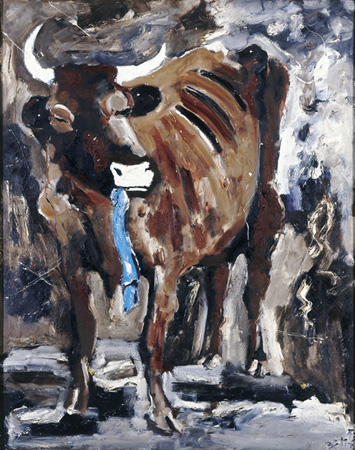| Werner Büttner |
|
 Ludwig Seyfarth Werner Büttner. Blaue Blume and blue pullover
In the late 1970s, nothing was more out than the art of painting. The gestural asceticism of conceptualism and minimalism had become established almost across the board, and the smell of oil paint was avoided like pathogens in a sterile environment. Yet like so many one-sided trends, in the end the suppressed affects erupted with renewed vigor and spawned an exaggerated penchant for the exact opposite. Germany experienced a boom of “young and wild” painting, exhibiting as little skilled craftsmanship as most of the punk music that was all the rage at the time.This was the climate in which Werner Büttner, Albert Oehlen, and later also Martin Kippenberger came together in Hamburg. At first glance, with their edgy-expressive pictures, the artist friends fitted into the neo-expressive cliché that was to flood the art market at the beginning of the 1980s, and which at times even commanded astronomical prices. But the three did not really belong to the New Wild painters, who, liberated from the burden of conceptualist theories, merely wanted just to let rip. It was the systematic inversion of 1968 slogans, long since degraded to empty phrases, and often cynical irony characterized their art, which oscillated between corny jokes and philosophical profundity. Together with Albert Oehlen, in 1976 Büttner had founded the Liga zur Bekämpfung des widersprüchlichen Verhaltens [League Against Contradictory Behavior], and in 1980 he started a Samenbank für DDR-Flüchtlinge [Sperm Bank for Refugees from the German Democratic Republic]. Till Briegleb described the features of the “new realistic absurdity” Büttner influenced, as “shadow-boxing with intellectual concepts and claims to philosophical validity, the Neo-dadaistic spectacle of neologisms and distortion of meanings, the sabotage of correctness through the invalidation of symbols.”[1] Unlike his one-time companion of many years Albert Oehlen, to this day Büttner has remained loyal to his purpose of connecting images and words ironically and ambiguously. Questions that are genuinely painterly and concern the very means of representation in painting, which Oehlen increasingly addressed, recede into the background in Büttner’s works, and instead an approach is foregrounded reminiscent of thinking in pictures as postulated by René Magritte. It had been rumored that Oehlen claimed Büttner possessed no talent for painting, apparently something which initially prompted the latter to pick up paintbrush and paints. Born in 1954 in Jena, Büttner had already been active in entirely different fields; he studied law at the Free University of Berlin and always had literary leanings to which belonged his penchant for subverting grand assertions and systems. “Fate socialized me into a refugee from the system,” the artist once declared, who had emigrated from the GDR to West Germany with his parents in the early 1960s. “So, I prefer works that are fragmentary, aphoristic and enigmatic: the small poetic thicket. The baggage of the system is too heavy for me.”[2] Thus, Büttner engaged in seemingly more peripheral and secondary concerns such as the “problems of crazy golf in the art of painting”, to which he devoted a series of canvases in 1982 that looked “as though de Chirico or Boullée had built his kids something for Christmas.”[3] [...] [1] Till Briegleb, “Pflege deine Zähne.” Süddeutsche Zeitung, July 9, 2003. [2] Cited in Harald Falckenberg, “Theorien von mittlerer Reichweite. Einige Details,” in: Uta Grosenick, ed., Werner Büttner – Verkehrte Welt, exhib. cat., Deichtorhallen Hamburg, Taschen, Cologne, 2003, p. 14. [3] Friedrich W. Heubach, “Bilder zum Erbarmen – für den Freund Werner Büttner”, in: Werner Büttner. Die Probleme des Minigolfs in der europäischen Malerei, exhib. cat., Galerie Max Hetzler, Cologne, 1983, p. 26. Catalog excerpt "Extended. Sammlung Landesbank Baden-Württemberg" Editors: Lutz Casper, Gregor Jansen, published by Kehrer Verlag Heidelberg, 2009 ^ Works in the ExhibitionWerner Büttner Desastres de la Democracia, 1980-1996 Disasters of Democracy Mixed media on paper 29,7 x 21 cm Werner Büttner Desastres de la Democracia, 1980-1996 Disasters of Democracy Mixed media on paper 29,7 x 21 cm Werner Büttner Desastres de la Democracia, 1980-1996 Disasters of Democracy Mixed media on paper 29,7 x 21 cm Werner Büttner Desastres de la Democracia, 1980-1996 Disasters of Democracy Mixed media on paper 29,7 x 21 cm Werner Büttner Desastres de la Democracia, 1980-1996 Disasters of Democracy Mixed media on paper 29,7 x 21 cm Werner Büttner Desastres de la Democracia, 1980-1996 Disasters of Democracy Mixed media on paper 29,7 x 21 cm Werner Büttner Desastres de la Democracia, 1980-1996 Disasters of Democracy Mixed media on paper 29,7 x 21 cm Werner Büttner Desastres de la Democracia, 1980-1996 Disasters of Democracy Mixed media on paper 29,7 x 21 cm Werner Büttner Desastres de la Democracia, 1980-1996 Disasters of Democracy Mixed media on paper 29,7 x 21 cm Werner Büttner Desastres de la Democracia, 1980-1996 Disasters of Democracy Mixed media on paper 29,7 x 21 cm Werner Büttner Badende Russen II, 1982 Bathing Russians II Oil on canvas 150 x 190 cm Werner Büttner Die Kuh, die den blauen Pullover gefressen hat, 1983 The Cow That Ate the Blue Pullover Oil on canvas 190 x 150 cm ^ Werner Büttner Die Kuh, die den blauen Pullover gefressen hat [The Cow That Ate the Blue Pullover] 1983 Oil on canvas 190 x 150 cm © Werner Büttner Foto: Archiv Sammlung Landesbank Baden-Württemberg ^ |
